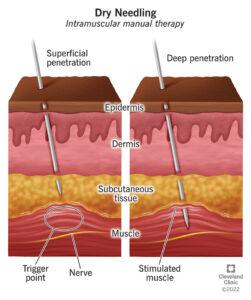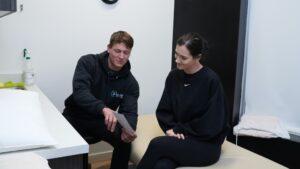In the ever-evolving world of physical therapy, practitioners are constantly exploring innovative techniques to alleviate pain and promote healing. One particular technique that has gained recent popularity over the past few years is dry needling, also known as intramuscular stimulation. This approach involves the precise insertion of fine needles into specific trigger points within muscles. In this post, we’re going to dive into the world of dry needling, exploring its benefits, mechanisms, and how it can be a game-changer in the realm of chronic pain relief.
Understanding dry needling
Dry needling is a form of therapy that uses thin, solid needles to penetrate the skin and stimulate underlying muscular trigger points. Unlike traditional acupuncture, which is rooted in traditional Chinese medicine and focuses on rebalancing energy flow, dry needling is firmly grounded in Western medicine principles.
What are the benefits of dry needling?
- Pain Relief: Dry needling is renowned for its effectiveness in pain management. By targeting trigger points within muscles, practitioners can induce a therapeutic response that reduces muscle tension and alleviates pain. This makes it a valuable tool in treating various musculoskeletal conditions, such as chronic back pain, neck pain, and tension headaches.
- Improved Range of Motion: Muscular tightness and knots can restrict your range of motion, hindering daily activities and impeding recovery. Dry needling helps release tension in specific muscle fibers, promoting improved flexibility and restoring a more natural range of motion.
- Enhanced Blood Flow: When your physical therapist inserts thin needles into muscle tissue, it stimulates blood flow to the targeted area. This increased circulation brings oxygen and nutrients to the muscles, promoting tissue healing.
- Trigger Point Identification: Trigger point dry needling allows physical therapists to identify and target specific trigger points. These are hyperirritable spots within muscles that are associated with palpable nodules or bands of muscle fibers. By releasing these trigger points, your physical therapist can address the root cause of pain and dysfunction.
How does dry needling work? 
The mechanisms behind the effectiveness of dry needling are multifaceted:
1.Muscle Relaxation: The insertion of needles into trigger points prompts a local twitch response in the muscle fibers. This twitch response signals the muscle to relax, releasing tension and reducing spasms. The relaxation of the muscle contributes to muscle pain relief and improved function.
2. Neurological Effects: Dry needling influences the nervous system by modulating pain signals. The stimulation of sensory nerves by the thin needle can disrupt the pain cycle, providing relief and altering the perception of pain in the brain.
3. Release of Neurotransmitters: The needling process triggers the release of endorphins, the body’s natural painkillers, and other neurotransmitters. This chemical response contributes to pain reduction and creates a sense of well-being.
Trigger point dry needling vs. Trigger point injections
While both trigger point dry needling and trigger point injections target muscular trigger points, they differ in their approach and substance used. Trigger point injections involve the injection of a solution, such as a local anesthetic or corticosteroid, into the trigger point.
On the other hand, dry needling utilizes a thin needle, without the injection of any substance. Both techniques aim to release tension and alleviate pain, but dry needling is often preferred for its minimal invasiveness and lack of medications.
 Therapeutic dry needling
Therapeutic dry needling
Therapeutic dry needling is a broader term that encompasses various dry needling techniques used for pain management and functional improvement. Physical therapists may employ superficial dry needling technique, targeting trigger points near the surface of the skin, or deep dry needling, reaching trigger points in deeper muscle layers. The choice of technique depends on the specific needs of the patient, and degree of musculoskeletal pain.
Relieving chronic pain with dry needling
If you experience chronic pain, you know that it can be debilitating and greatly impact your quality of life. Dry needling therapy offers a promising avenue for chronic pain relief by addressing the underlying causes. Here’s how it can help:
- Disrupting Pain Pathways: Chronic pain often involves a complex interplay of signals within the nervous system. During a dry needling session, your physical therapist is able to interrupt these pain pathways, providing relief and helping reset the body’s response to pain stimuli.
- Muscle Dysfunction Correction: Chronic pain is frequently associated with muscular dysfunction whether that be muscle pain, muscle tightness, muscle spasm, or muscle soreness. Dry needling targets trigger points and dysfunctional muscle fiber, promoting proper muscle function and reducing pain over time.
- Promoting Healing: The increased blood flow and release of neurotransmitters during dry needling contribute to the healing process. This is particularly beneficial for chronic conditions where tissue repair and regeneration are crucial for sustained pain relief.
Schedule dry needling at Synergy Rehab
Dry needling is a powerful tool for pain management and functional improvement that has helped thousands of our patients recover from injury and manage pain. Its ability to target specific trigger points within muscles, coupled with its minimal invasiveness, makes it an attractive option for those seeking relief from chronic pain.
As physical therapy continues to explore and refine techniques for pain relief, dry needling has emerged as a valuable modality with the potential to transform lives. If you’re considering physical therapy for chronic pain management, exploring the benefits of dry needling could be a pivotal step toward a pain-free and more functional future! Schedule a same-day appointment for dry needling at your local Synergy Rehab today!








